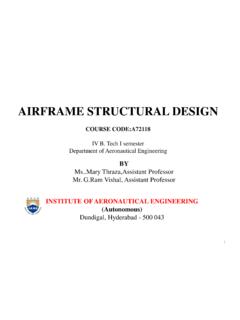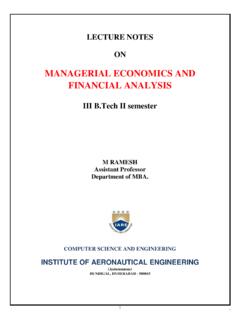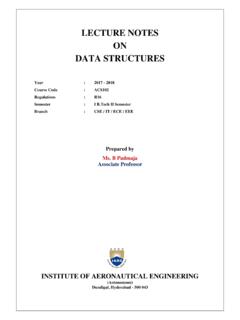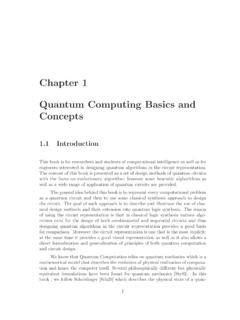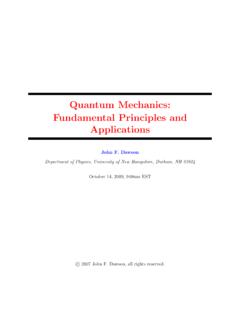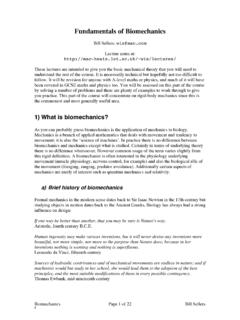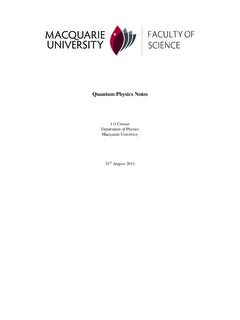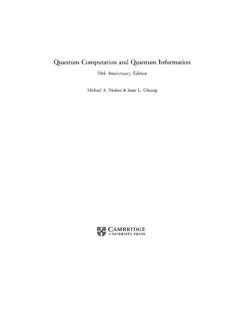Transcription of LECTURE NOTES ON ENGINEERING MECHANICS B. Tech III ...
1 1 LECTURE NOTESONENGINEERING MECHANICSB. Tech III Semester (R-18)Prepared ByDr. Ch. SandeepAssociate ProfessorV. PrasannaAssistant ProfessorMECHANICAL ENGINEERING INSTITUTE OF AERONAUTICAL ENGINEERING (Autonomous)Dundigal, Hyderabad - 500 043Dr. BDY SunilDr. BDY Sunil1 | P a g e ENGINEERING MECHANICS III Semester: ME Course Code Category Hours / Week Credits Maximum Marks AMEB03 Foundation L T P C CIA SEE Total 3 1 - 4 30 70 100 Contact Classes: 45 Tutorial Classes: 15 Practical Classes: Nil Total Classes: 60 COURSE OBJECTIVES: The student will try to learn: I. The application of MECHANICS laws to static and dynamic equilibrium conditions in a body for solving the field problems. II. The importance of free body diagram for a given system and put in the knowledge of mathematics and science into the vast area of rigid body MECHANICS .
2 III. The effects of force and motion while carrying out the innovative design functions of ENGINEERING . COURSE OUTCOMES (COs): CO 1: Determine the reactions and resultants for the system of forces in ENGINEERING applications with principles of MECHANICS . CO 2: Analyze the unknown forces with the help of free body diagrams to a given force system. CO 3: Identify the equilibrium equations for a planar and spatial force systems from the rest or motion condition of the body CO 4: Apply the static and dynamic friction laws for the equilibrium state of a wedge and ladder applications. CO 5: Apply the friction laws to a standard and differential screw jack for conditions of self-locking and overhauling. CO 6: Demonstrate the concepts of equilibrium for truss, beam, frames and machine applications.
3 CO 7: Identify the centroid, centre of gravity and moment of inertia for the simple plane sections from the first principles . CO 8: Explore the theorems of moment and the mass moment of inertia of circular plate, cylinder, cone and sphere. CO 9: Apply the concepts of virtual work and work-energy method for single and connected configured systems. CO 10: Determine normal and tangential accelerations for a particle in rectilinear and curvilinear motion through kinematic equations. CO 11: Derive the dynamic equilibrium of a body in motion by introducing inertia force through D Alembert s principle. CO 12: Compute the time period and frequencies of simple, compound and torsional pendulums using the basics of free and forced vibrations.
4 2 | P a g e MODULE-I INTRODUCTION TO ENGINEERING MECHANICS Classes: 10 Force Systems Basic concepts, Particle equilibrium in 2-D Rigid Body equilibrium; System of Forces, Coplanar Concurrent Forces, Components in Space Resultant- Moment of Forces and its Application; Couples and Resultant of Force System, Equilibrium of System of Forces, Free body diagrams, Equations of Equilibrium of Coplanar Systems and Spatial Systems; Static Indeterminacy. MODULE -II FRICTION AND basics STRUCTURAL ANALYSIS Classes: 09 Types of friction, Limiting friction, Laws of Friction, Static and Dynamic Friction; Motion of Bodies, wedge friction, screw jack & differential screw jack; Equilibrium in three dimensions; Method of Sections; Method of Joints; How to determine if a member is in tension or compression; Simple Trusses; Zero force members; Beams &types of beams; Frames &Machines.
5 MODULE -III CENTROID AND CENTRE OF GRAVITY AND VIRTUAL WORK AND ENERGY METHOD Classes: 10 Centroid of simple figures from first principle, centroid of composite sections; Centre of Gravity and its implications; Area moment of inertia- Definition, Moment of inertia of plane sections from first principles , Theorems of moment of inertia, Moment of inertia of standard sections and composite sections; Mass moment inertia of circular plate, Cylinder, Cone, Sphere, Hook. Virtual displacements, principle of virtual work for particle and ideal system of rigid bodies, degrees of freedom. Active force diagram, systems with friction, mechanical efficiency. Conservative forces and potential energy (elastic and gravitational), energy equation for equilibrium.
6 Applications of energy method for equilibrium. Stability of equilibrium. MODULE -IV PARTICLE DYNAMICS AND INTRODUCTION TO KINETICS Classes: 08 Particle dynamics- Rectilinear motion; Plane curvilinear motion (rectangular, path, and polar coordinates). 3-D curvilinear motion; Relative and constrained motion; Newton s 2nd law (rectangular, path, and polar coordinates). Work-kinetic energy, power, potential energy. Impulse-momentum (linear, angular); Impact (Direct and oblique). Introduction to Kinetics of Rigid Bodies covering, Basic terms, general principles in dynamics; Types of motion, Instantaneous centre of rotation in plane motion and simple problems. MODULE -V MECHANICAL VIBRATIONS Classes: 08 Basic terminology, free and forced vibrations, resonance and its effects; Degree of freedom; Derivation for frequency and amplitude of free vibrations without damping and single degree of freedom system, simple problems, types of pendulum, use of simple, compound and torsion pendulums.
7 Text Books: 1. Irving H. Shames (2006), ENGINEERING MECHANICS , Prentice Hall, 4th Edition,2013 2. F. P. Beer and E. R. Johnston (2011), Vector MECHANICS for Engineers , Vol I - Statics, Vol II, Dynamics, Tata McGraw Hill , 9th Edition,2013. 3. R. C. Hibbler (2006), ENGINEERING MECHANICS : principles of Statics and Dynamics , Pearson Press. 3 | P a g e Reference Books: 1. , ATextBookofEngineeringMechanics ,NewAgeInternational,1st Edition,2012 2. , ENGINEERING MECHANICS , Uma Publications, 14th Edition, 2013. 3. R. K. Bansal ENGINEERING MECHANICS , Laxmi Publication, 8thEdition, 2013. 4. Basudeb Bhattacharya, ENGINEERING MECHANICS , Oxford University Press, 2nd Edition, 2014. 5. Reddy, J. Suresh Kumar, Singer s ENGINEERING MECHANICS Statics and Dynamics , B Publishers, 1st Edition, 2013.
8 Web References: 1. ( MECHANICS ) 2. E-Text Books: 1. 2. 3. MODULE I INTRODUCTION TO ENGINEERING MECHANICS COURSE OUTCOMES (COs): At the end of the course students are able to: Course Outcomes Knowledge Level (Bloom s Taxonomy) CO 1 Determine the reactions and resultants for the system of forces in ENGINEERING applications with principles of MECHANICS . Apply CO 2 Analyze the unknown forces with the help of free body diagrams to a given force system. Analyze CO 3 Identify the equilibrium equations for a planar and spatial force systems from the rest or motion condition of the body. Remember PROGRAM OUTCOMES (POs): The branch of physical science that deals with the state of rest or the state of motion of a body/particle is termed as MECHANICS .
9 Application of laws of MECHANICS , such as Newtonian MECHANICS , Einstein s Relativistic MECHANICS and quantum MECHANICS , to the field problem is termed as ENGINEERING MECHANICS . This can be treated as the definition of ENGINEERING MECHANICS . In this definition, if you observe carefully, the term particle or a body is the term used for the object which we consider in the problem. The body/particle may be as small as a molecule or as big as a building. It is a general term used for the object being considered in the problem. Also, the term field problem refers to the problem in practical applications , a real time application. Now let us discuss about the classification of ENGINEERING MECHANICS . Depending upon the body to which MECHANICS is applied, ENGINEERING MECHANICS is classified as: (a) MECHANICS of Solids and (b) MECHANICS of Fluids Program Outcomes (POs) Strength Proficiency Assessed by PO 1 ENGINEERING knowledge: Apply the knowledge of mathematics, science, ENGINEERING fundamentals, and an ENGINEERING specialization to the solution of complex ENGINEERING problems.
10 3 CIE/Quiz/AAT PO 2 Problem analysis: Identify, formulate, review research literature, and analyze complex ENGINEERING problems reaching substantiated conclusions using first principles of mathematics, natural sciences, and ENGINEERING sciences 1 CIE/Quiz/AAT PO 4 Conduct Investigations of Complex Problems: Use research-based knowledge and research methods including design of experiments, analysis and interpretation of data, and synthesis of the information to provide valid conclusions. 1 Seminar/ conferences / Research papers The flow chart of classification can be seen here: [classification figure] The broad classification of ENGINEERING MECHANICS can be given into MECHANICS of Solids and MECHANICS of Fluids.
